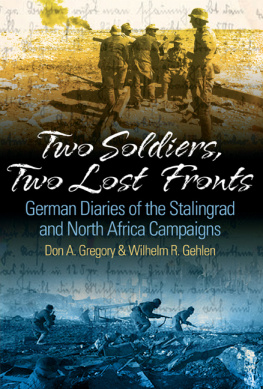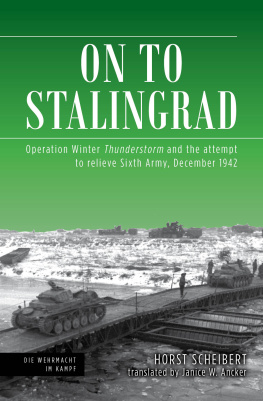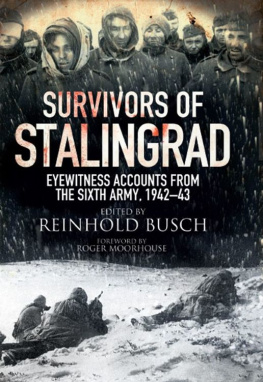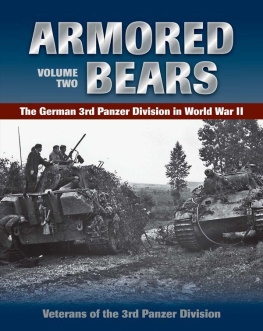

Published in the United States of America in 2009 by
CASEMATE
1016 Warrior Road, Drexel Hill, PA 19026
and in the United Kingdom by
CASEMATE
17 Cheap Street, Newbury RG20 5DD
Copyright Don A. Gregory and Wilhelm R. Gehlen 2009
ISBN 978-1-935149-05-7
Cataloging-in-publication data is available from the Library of Congress and the British Library.
All rights reserved. No part of this book may be reproduced or transmitted in any form or by any means, electronic or mechanical including photocopying, recording or by any information storage and retrieval system, without permission from the Publisher in writing.
10 9 8 7 6 5 4 3 2 1
Printed and bound in the United States of America.
For a complete list of Casemate titles please contact:
CASEMATE PUBLISHERS
Telephone (610) 853-9131, Fax (610) 853-9146
E-mail: casemate@casematepublishing.com
or
CASEMATE UK
Telephone (01635) 231091, Fax (01635) 41619
E-mail: casemate-uk@casematepublishing.co.uk
For
Judith and Barbara
PREFACE
These diaries allow a glimpse into the lives of two German soldiers. Neither was famous nor of especially high rank, and no books have been written on their military careers. Diaries and memoirs written by high-ranking military and political leaders of World War II abound, but the remembrances and diaries of those who were directly responsible for carrying out the orders given from on high are rare, and those that are available are often sketchy with little detail. This is certainly understandable since those actually involved in the battles did not have the time nor the inclination to examine the overview of what they were experiencing during combat, and they were not very interested in writing about it afterward.
The unique feature of both of these diaries is that they were written as the events occurred, not after the war when memories have faded and historical revisions have been encouraged for social or political reasons. These are the real stories, not written for a general audience, or really for any audience at all. Perhaps they illustrate just how the reach of Hitler exceeded his grasp when he opened and tried to maintain fronts in both Russia and North Africa. History records the two front war as being the Eastern and Western fronts; however, there was a third front in North Africa as well. These campaigns truly signaled the end of the beginning phase of the war and the beginning of the end of the Third Reich.
The first diary, initially attributed to Oberfeldwebel (Master Sergeant) Ludwig Bloos, was a printed copy with distribution limited to the German Wehrmacht. Bloos is mentioned in Franz Kurowskis book Panzer Aces: German Tank Commanders in World War II (Ballentine, 2002). Recent research on Knights Cross winners has determined that the diary was not actually written by Bloos but merely signed by him. The assignment for keeping the diary was probably given to one of the members of the 201st Panzer Regiment by one of the commanding officers, and the author never saw fit to include his own name. It is obvious from the writing style and the subjects covered in the diary, however, that it was not written by a high-ranking officer but by someone closely in touch with day-to-day events. The 201st Panzer Regiment did cross paths with Bloos outfit, the 11th Panzer Regiment, on at least one occasion near Stalingrad. That is perhaps where the author of the diary and others in the 201st became acquainted with Bloos. It is also conceivable that, some time later, the owner of the diary simply wanted the autograph of a Knights Cross winner on his copy. We have included a short biography of Bloos at the end of the book.
The second diarys author is well known today. His name was Rolf Krengel and the diary is the original, handwritten copy, complete with some well-done drawings made by Krengel, and it includes a few photographs. A separate photo album, with Krengel named as the owner, accompanied this diary as well, and some of those photographs and drawings have been reproduced here. The diary is also signed by two of the notable figures of the war: General Erwin Rommel and Colonel Claus von Stauffenberg. It was in Africa that von Stauffenberg, who would later attempt to assassinate Hitler, was severely wounded on April 7, 1943.
Professor Krengel, as he was later to become, died in 2002, and economic scholars worldwide noted his passing. His obituary appears at the end of this book. He was best known for his work after the war, beginning in 1948 in assisting U.S. General Lucius Clays organization of the Berlin Airlift. The final entry in the diary refers to his initial meeting with Clays staff.
We can see the big picture now, given the historical accounts, but as the events unfolded in real time, only quick snapshots were available to the soldiers, and that is evident in reading the diaries. Rarely is anything mentioned about the eventual outcome of the battles they were involved in, because the diaries were written as the battles occurred and neither author saw fit to offer comments afterward. This is especially notable in the Krengel diary when, after his departure from North Africa, he declines to even mention the capitulation of the Axis forces hed left behind, including his own 21st Panzer Division. It is understandable, however; individual soldiers are generally not given the overall goals or debriefed after the mission is completed. They are simply going about their jobs as soldiers, mostly oblivious to the political implications of the campaigns in which they are involved. Both diaries also show what every soldier knows about the drudgery of war, the hurry up and wait, the plans that dont work, and the loss of life of comrades. Perhaps this is the perspective that is gained by reading war diaries written not by the generals but by the soldiers on the ground.
We have devoted a considerable amount of effort toward translating the diaries accurately while also giving background to the story as told by the writer. To that end, we have not spent a great deal of time researching all of the tongue breaking (as one of the diarists calls them) names of the small towns encountered. We have reproduced the names exactly as they were given in the diaries. Many of them have changed names (and spellings) several times since the war, or they simply no longer exist. Some we could identify, others we just left as they were written in the diaries. A map was included in the Stalingrad diary with the route of the 23d Panzer Division marked, along with additional notations to clarify highlights. The major towns and landmarks are still there and the major roads are still in use.
Both diaries illustrate just how critical fuel shortages and supply routes were in each campaign. In many instances, opportunities were missed because of a lack of fuel for the tanks, and battles were definitely lost because in both Russia and Africa the vehicles could not maneuver. Reconnaissance missions were cancelled, and in some cases tanks were left behind because they had run out of fuel. Paulus in Stalingrad might have been rescued and all of North Africa might have been occupied for years if the fuel situation had been solved. In any case, it would have been a very different war.
Our purpose in writing this book is to present insight into the lives of two soldiers, not to explore or interpret the history itself. Nevertheless, we have added timelines and additional information about the campaigns and units in order to help the reader put the diaries in context. We have also chosen to make some translations more readable by converting German military ranks to their American or British equivalent, except when the German rank is popularly known, and we have made some conversions from the metric system to the English system when we felt they were warranted. Some paragraphs have been broken up for readability. Whenever possible, we have identified individual soldiers mentioned in the diaries and have given small details about them when they were available. We have limited the details to those pertinent to their service during or near the time covered by the diaries, so awards won later are generally not mentioned. Our comments and notes throughout the diaries are given in brackets [ ].












